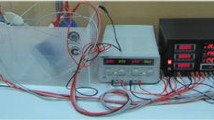Abstract
In this study the electrochemical technique is applied to accelerate chloride ion migration in concrete to determine the chloride ions in anode cell. This paper presents a new method for determining the chloride migration rate in concrete from steady state migration test by measuring the electrical current. The plain ordinary Portland cement concrete and concrete containing different type of mineral admixtures (fly ash and slag) with w/b ratios of 0.35, 0.45, 0.55, and 0.65 were used.For a given charge passed in steady state, the current corresponding to the given charge passed was correlated with the chloride migration rate. The results for all mixtures show that the chloride migration rate and the current corresponding to a given charge passed in steady state is linearly correlated.
Résumé
Dans cette étude, la technique électrochimique est appliquée pour accélérer la migration des ions de chlorure dans ciment pour déterminer les ions chlorure dans les cellules anode. Cet article présente une nouvelle méthode pour déterminer le taux de migration de chlorure dans le ciment à partir d'essais en régime permanent en mesurant le courant électrique. Du ciment simple et ordinaire de Portland et du ciment contenant différents types de mélanges minéraux (cendres volantes et scories) avec des rapports eau/liant de 0,35, 0,45, 0,55 et 0,65 ont été utilisés. Pour une charge donnée passée en régime permanent, le courant correspondant à la charge passée est corrélé avec le taux de migration de chlorure. Les résultats pour les différents mélanges montrent tous que cette corrélation est linéaire.
Similar content being viewed by others
References
Page, C.L., Short, N.R. and Tarros, A. El, ‘Diffusion of chloride ions in hardened cement pastes’,Cement and Concrete Research 11 (3) (1981) 395–406.
Dhir, R.K. and Byars, E.A., ‘PFA concrete: chloride diffusion rates’,Magazine of Concrete Research 45 (1993) 1–9.
Castellote, M., Andrade, C. and Alonso, C., ‘Measurement of the steady and non-steady-state chloride diffusion coefficients in a migration test by means of monitoring the conductivity in the anolyte chamber comparison with natural diffusion tests’,Cement and Concrete Research 31 (2001) 1411–1420.
Standard test method for electrical indication of concrete's ability to resist chloride ion penetration, ASTM C 1202-97, American Society for Testing and Materials (1997).
Andrade, C., ‘Calculation of chloride diffusion coefficients in concrete from ionic migration measurements’,Cement and Concrete Research 23 (1993) 724–742.
Zhang, T. and Gjørv, O.E., ‘An electrochemical method for accelerated testing of chloride diffusivity in concrete’,Cement and Concrete Research 24 (1994) 1534–1548.
Detwiler, R.J., Fapohunda, C.A. and Natale, J., ‘Use of supplementary cementing materials to increase the resistance to chloride ion penetration of concretes cured at elevated temperatures’,ACI Material Journal 91 (1994) 63–66.
Tang, L. and Nilsson, L.-O., ‘Rapid determination of the chloride diffusivity in concrete by applying an electrical field’,ACI Material Journal 89 (1992) 49–53.
Whiting, D., ‘Rapid measurements of chloride permeability of concrete’,Public Roads 45 (1981) 101–112.
Feldman, R.F., Chan, G.W., Brousseau, R.J. and Tumldajski, P.J. ‘Investigation of the rapid chloride permeability test’,ACI Material Journal 91 (1994) 246–255.
Feldman, R.F., Prudencio Jr., L.R. and Chan, G., ‘Rapid chloride permeability test on blended cement and other concretes: correlations between charge, initial current and conductivity’,Construction and Building Materials 13 (1999) 149–154.
Sugiyama, T., Tsuji, Y. and Bremner, T.W., ‘Relationship between coulomb and migration coefficient of chloride ions for concrete in a steady-state chloride migration test’,Magazine of Concrete Research 53 (2001) 13–24.
Tong, L. and Gjørv, O.E., ‘Chloride diffusivity based on migration testing’,Cement and Concrete Research 31 (2001) 973–982.
Truc, O., Ollivier, J.-P. and Carcassès, M., ‘A new way for determining the chloride diffusion coefficient in concrete from steady state migration test’,Cement and Concrete Research 30 (2000) 217–226.
Yang, C.C., Cho, S.W. and Huang, R., ‘The relationship between charge passed and the chlorideion concentration in concrete using steady-state chloride migration test’,Cement and Concrete Research 32 (2002) 217–222.
Castellote, M., Andrade, C. and Alonso, C., ‘Modelling of the processes during steady-state migration test: quantification of transference numbers’,Mater. Struct. 32 (1999) 180–186.
Halamickova, P., Detwiler, R.J., Bentz, D.P. and Garboczi, E.J., ‘Water permeability and chloride ion diffusion in Portland cement mortars: relationship to sand content and critical pore diameter’,Cement and Concrete Research 25 (1995) 790–802.
Yang, C.C., ‘The relationship between charge passed and the chloride concentrations in anode and cathode cells using the accelerated chloride migration test’,Mater. Struct. 36 (264) (2003) 678–684.
Author information
Authors and Affiliations
Rights and permissions
About this article
Cite this article
Yang, C.C., Cho, S.W. The relationship between chloride migration rate for concrete and electrical current in steady state using the accelerated chloride migration test. Mat. Struct. 37, 456–463 (2004). https://doi.org/10.1007/BF02481582
Received:
Accepted:
Issue Date:
DOI: https://doi.org/10.1007/BF02481582




